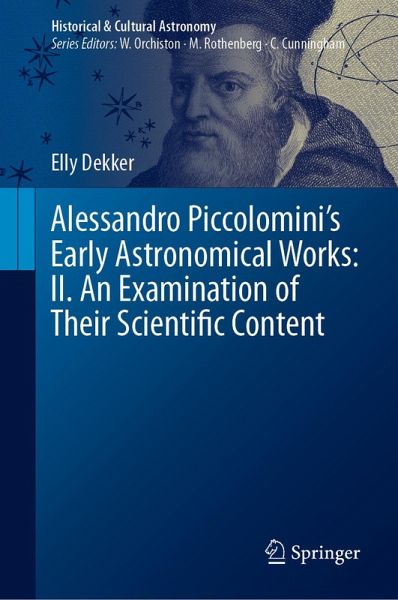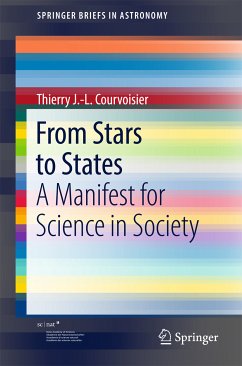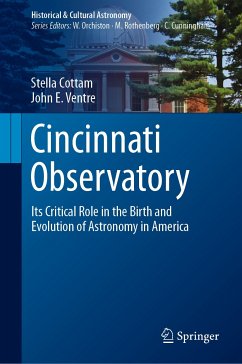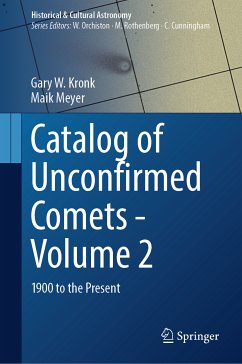
Alessandro Piccolomini's Early Astronomical Works: II. An Examination of Their Scientific Content (eBook, PDF)
Versandkostenfrei!
Sofort per Download lieferbar
112,95 €
inkl. MwSt.
Weitere Ausgaben:

PAYBACK Punkte
56 °P sammeln!
This book presents the first detailed scientific examination of Alessandro Piccolomini's two early astronomical works - De la Sfera del Mondo and De le Stelle Fisse. First published in Venice in 1540, the two treatises are amongst the earliest scientific texts written in the vernacular (Italian) and were specifically composed to make astronomical principles and practices available to a lay reader.Whereas De la Sfera del Mondo is essentially an updated adaptation of the theoretical astronomical material contained in Sacrobosco's De Sphaera, this book examines his views on a number of key topics...
This book presents the first detailed scientific examination of Alessandro Piccolomini's two early astronomical works - De la Sfera del Mondo and De le Stelle Fisse. First published in Venice in 1540, the two treatises are amongst the earliest scientific texts written in the vernacular (Italian) and were specifically composed to make astronomical principles and practices available to a lay reader.
Whereas De la Sfera del Mondo is essentially an updated adaptation of the theoretical astronomical material contained in Sacrobosco's De Sphaera, this book examines his views on a number of key topics - such as precession, the motion of the solar apogee and the size and distance of the planets from Earth.
The author also presents a radical reassessment of De le Stelle Fisse, focusing on the innovative methods Piccolomini employed to create a viewer-centric approach for identifying the stars. As such, Piccolomini's guide to the heavens should be seen as a distant forerunner of the successful genre of elementary handbooks that were developed in the late 18th century, and which remain popular with amateur stargazers even in the 21st century.
The book also addresses how Piccolomini's treatises were used by contemporary astronomers by examining the manuscript notes that were left in various surviving copies of his books. It provides a convincing explanation of the unique directional notation on his stellar maps and assesses the relative accuracy of his stellar co-ordinates against contemporary and modern ephemerides and pictorial sources. It also argues that Piccolomini probably designed his distinctive series of maps of the constellations and the related Tables by using a celestial globe to compile his astronomical data. Finally, the author examines the series of refinements and corrections in the successive editions of Piccolomini's two treatises, thereby showing the extent to which his two early astronomical treatises remained an on-going enterprise for over 60 years.
This book is a companion volume to Alessandro Piccolomini's Early Astronomical Works: I. An Exploration of Their Cultural Significance by Kristen Lippincott in the same series. The two volumes are jointly available as print set with ISBN 978-3-031-76964-1.
Whereas De la Sfera del Mondo is essentially an updated adaptation of the theoretical astronomical material contained in Sacrobosco's De Sphaera, this book examines his views on a number of key topics - such as precession, the motion of the solar apogee and the size and distance of the planets from Earth.
The author also presents a radical reassessment of De le Stelle Fisse, focusing on the innovative methods Piccolomini employed to create a viewer-centric approach for identifying the stars. As such, Piccolomini's guide to the heavens should be seen as a distant forerunner of the successful genre of elementary handbooks that were developed in the late 18th century, and which remain popular with amateur stargazers even in the 21st century.
The book also addresses how Piccolomini's treatises were used by contemporary astronomers by examining the manuscript notes that were left in various surviving copies of his books. It provides a convincing explanation of the unique directional notation on his stellar maps and assesses the relative accuracy of his stellar co-ordinates against contemporary and modern ephemerides and pictorial sources. It also argues that Piccolomini probably designed his distinctive series of maps of the constellations and the related Tables by using a celestial globe to compile his astronomical data. Finally, the author examines the series of refinements and corrections in the successive editions of Piccolomini's two treatises, thereby showing the extent to which his two early astronomical treatises remained an on-going enterprise for over 60 years.
This book is a companion volume to Alessandro Piccolomini's Early Astronomical Works: I. An Exploration of Their Cultural Significance by Kristen Lippincott in the same series. The two volumes are jointly available as print set with ISBN 978-3-031-76964-1.
Dieser Download kann aus rechtlichen Gründen nur mit Rechnungsadresse in A, B, BG, CY, CZ, D, DK, EW, E, FIN, F, GR, HR, H, IRL, I, LT, L, LR, M, NL, PL, P, R, S, SLO, SK ausgeliefert werden.












